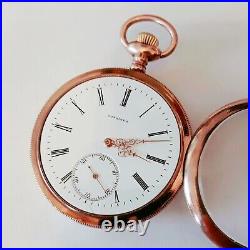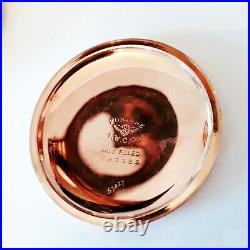Mar 24 2024
Antique LONGINES Swiss/Canadian Pocket Watch 16s 15 Jewels Gold Filled Case
Posted by in antique













In excellent cosmetic and working condition! Keeps time in all positions! Complete service (disassembly, cleaning, lubrication, adjustment). The serial number of the movement is 2053819. Which corresponds to the 1907 issue. The Enamel dial has a very short hairline (please see photo). But overall it is in very good condition. American Watch Case Co. The Case has no dents or deep scratches. All caps screw on easily and correctly. The Mineral Crystal is without chips or cracks. But has minor scratches from use and time. Crown and Ring are perfect. Pocket watch diameter 51 mm. CH 16831 Raquette Brisebard. The symbol of the Swiss Federal cross Swiss Federal Cross stamped onto a watch movement indicates a Swiss patent. The number 16831 alongside this in the centre of the regulator pivot on a balance cock indicates a Swiss patent titled “Raquette Brisebard”. Swiss patent CH16831 was granted to Charles Brisebard of Besançon, France, on 21 May 1898. And it was evidently assigned or licensed to Longines. The purpose of the design is to allow the regulator lever to be turned, without moving the curb pins, so that the regulator lever points to the centre of the scale on the balance cock. When the curb pins are moved to the correct place on the balance spring to bring the movement to time, the regulator pointer is usually slightly off centre on the scale. Usually the only way to change this is by adding or removing mass from the balance. The regulator lever, instead of being made as a single part, was made in two parts. One part comprises a complete ring with a long pointer/lever that points to the Faster/Slower scale on the balance cock. A second partial ring, which carries the curb pins on a radial arm, fits tightly around the ring on the end of the lever. The tight fit of the partial ring means that moving the lever will normally cause the partial ring and curb pins to move with it, but the partial ring can also be turned on the regulator lever ring by holding one and turning the other. The drawing shows a possible alignment, with the curb pin carrier in line with the regulator lever. Alternative positions of the curb pins are shown ghosted. The red arrows show how the parts are assembled to pivot in the normal way around a disc fixed to the balance cock by two screws. The green arrow indicates a small rectangular part which carries the curb pins and is fixed by a screw (not shown) to a slot in the carrier. The slot in the carrier allows the curb pins to be moved inwards or outwards. Please see all the photos, and if you have any questions. Please contact me, I will be happy to answer. For buyers from other countries, depending on current tariffs. You can write me your zip code to determine the exact cost.